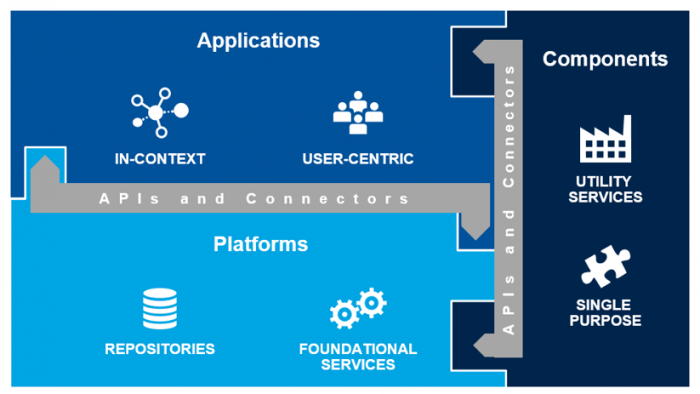Why You Should Know About Content Services
In 2017, Michael Woodbridge, a Research Director with Gartner wrote a piece titled The Death of ECM and Birth of Content Services where he retired the term “enterprise content  management” and gave rise to the new market term “content services platforms” which aligns with how systems interoperate and how people access information in today’s reality.
management” and gave rise to the new market term “content services platforms” which aligns with how systems interoperate and how people access information in today’s reality.
“The term ‘enterprise content management’ no longer reflects market dynamics or the organizational needs for content in digital business. For applications leaders in charge of content management projects, this means casting aside previous notions and rethinking their technology approaches.” – Gartner
What Are Content Services?
According to Gartner’s report content services “are a set of services and microservices, embodied either as an integrated product suite or as separate applications that share common APIs and repositories, to exploit diverse content types and to serve multiple constituencies and numerous use cases across an organization.”

Gartner breaks down content services into three categories:
Content Services Platforms: Content services platform will have its own repository and may also integrate external repositories through connectors and APIs (e.g., CMIS) or packaged integrations. Content services platforms are integrated sets of content-related services, microservices, repositories and tools that support common enterprise content use cases. The set of services typically includes document management, search, indexing, categorization, capture, version control, workflow, records management, content analytics and more. Content services platforms support a variety of deployment options, including on-premises, in the cloud or in hybrid architectures.
Content Services Applications: Content services applications are derived from a more focused collection of content-related services and microservices than are content services platforms. These applications are generally specific to vertical industries or specific horizontal use cases and provide a solution to a distinct, content-driven business problem. Examples include correspondence management, case and claims management, contracts management and patient records management.
Content Services Components: Content services platforms have a base set of services and microservices, and content services applications will be built using them. However, in a services-oriented world, enterprises will no longer be tied to the idea of buying a package that does everything inside of it. These solutions may or may not have an end-user interface, but enhance the capabilities of content in some way. Services may come from multiple platforms or providers and be integrated together and with other applications. Examples include:
-
An application that analyzes and automatically tags content.
-
A service that automates the generation of new content based on datasets, business rules, and multiple content sources.
-
A service that allows business users, without support from IT, to build ad-hoc workflows (e.g., collaboration or review/approval) based on forms or templates.
-
An application for teams of workers to proactively share knowledge and assets.
-
A service that translates content from one language to another.
What’s the Difference Between Content Services and ECM?
The goal of an ECM was to have a centralized platform where a wide range of operational activities can be pull from. Many organizations have seen success by using ECM as a centralized system. Basically, content services is a new approach to improving operational efficiency, and it relies on multiple tools and strategies to get the job done. In Reinventing ECM: Introducing Content Services Platforms and Applications, Gartner discusses the differences between these two approaches:
“The transformation from ECM to content services denotes an important conceptual shift away from the “management” of content and too much focus on the repository as the solution. Redefining the market as content services recognizes that it is no longer strictly about the storage of content for the enterprise, but rather about the consideration of how content is used by individuals and teams — internally and externally — to create, collaborate, share, transform, and leverage that content in business processes and to gain insight. This transformation will be a multiyear evolution in many organizations, and reflects a change in requirements from buyers, affecting several markets.”
The content services approach looks beyond the consideration of where content is being stored and focuses on other important aspects that need to be considered:
-
Who is storing and processing the content?
-
How can a unified content strategy help those individuals work more efficiently?
-
What additional technologies can be integrated with the centralized storage platform in order to achieve business goals?
Answering the above questions will allow you to take a more comprehensive, strategic approach to improving your operations. Leveraging multiple resources will improve collaboration, increase productivity and allow you to work smarter as a whole.
How Can Organizations Benefit from Content Services?
By combining different content services platforms, applications and components it allows your organization to take advantage of what each technology solution does best. Integration of the information and functionality from different systems will allow you to save time and money while producing lasting operational benefits. Here are some key benefits:
Improved Information Access and Sharing - It enables all content, wherever it resides, to be quickly and easily searched and retrieved. The process services within some content services solutions allow you to automate and manage the flow of content within and across departments.
Flexibility, Scalable and Cloud - These platforms enable organizations to quickly configure and deploy solutions to handle the increase in volume and complexity. This is a major step toward shifting content management to the cloud. These new ECM capabilities are delivered as web-based services—content services platforms can be quickly deployed and are easily scalable.
Empowered Knowledge - Delivering the right content to the right people at the right time. Users can access and interact with the content they need from within the application they’re using through customized workspaces.
Ending Notes
Context is everything when dealing with content services, ultimately, ECM and content services seek to achieve the same goals, but they just take a different approach in doing so. With Gartner changing the term ECM to content service platform there is now a new set of standards for content organizations. Content is expected to live in a repository and be used only when and how it’s needed. Versioning and huge storage solutions are all going to be a thing of the past.
A content services platforms means that there’s only a single version of any one document. It’s a little like switching Word docs with Google Docs, but on a larger scale. For end-users, it means we can finally achieve the content management results we've been promised for years, along with a truly seamless experience.

Natalie Evans
Natalie Evans has over 16-years in the tech industry and currently works as the event coordinator and tech reporter for CMS-Connected, keeping up-to-date on what's happening in and around the Content Management industry.